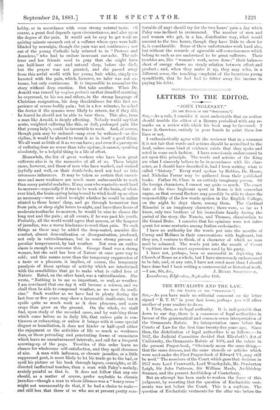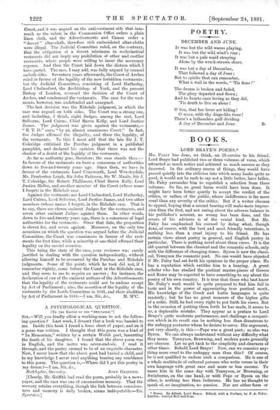THE RITUALISTS AND THE LAW.
[To THE EDITOR OF THE "SPECTATOR.") SIR,—As you have made no editorial comment on the letter signed "R. T. D." in your last issue, perhaps you will allow another of your readers to do so.
1. First, then, as to legal authority. It is indisputable that down to our day, there is a consensus of legal authorities in favour of the grammatical and common-sense interpretation of the Ornaments Rubric. Its interpretation came before the Courts of Law for the first time twenty-five years ago. Since then, the distribution of legal authorities is as follows :—In 1857, the Judicial Committee decided that Elizabeth's Act of Uniformity, the Ornaments Rubric of 1604, and the rubric in the present Prayer-book, "Obviously mean the same thing,— that the same dresses, and the same utensils or articles which were used under the First Prayer-book of Edward VI., may still be used." The members of the Court which gave that decision in 1857 were Lord Cranworth, Lord Wensleydale, Mr. Pemberton Leigh, Sir John Patteson, Sir William Maule, Archbishop Sumner, and the present Archbishop of Canterbury.
But an attempt has been made to weaken the force of this judgment, by asserting that the question of Eucharistic vest- ments was not before the Court. This is a sophism. The question of Eucharistic vestments for the altar was before the Court, and it was argued on the anti-vestment side that inas- much as the rubric in the Communion Office orders a plain linen cloth, and the Advertisements and Canon order a " decent " altar-cloth, therefore rich embroidered altar-cloths were illegal. The Judicial Committee ruled, on the contrary, that the obligation of a decent minimum in ecclesiastical vestments did not imply any prohibition of other and costlier vestments, where people were willing to incur the necessary expense. And then the Court laid down the dictum which I have quoted. The case, I may add, was fully argued by counsel on both sides. Seventeen years afterwards, the Court of Arches ruled in favour of the legality of the now forbidden vestments ; but the Judicial Committee, consisting of Lord Hatherley, Lord Chelmsford, the Archbishop of York, and the present Bishop of London, reversed the decision of the Court of Arches, and condemned the vestments. The case for the vest- ments, however, was undefended and unargned.
The last decision was the Ridsdale judgment, in which the case was argued on both sides. The Court was a strong one, and including, I think, eight Judges, among the rest, Lord Selborne, Lord Cairns, Chief Baron Kelly, and Lord Justice James. The judgment was given against the vestments,— " R. T. D." says, "by an almost unanimous Court." In fact, five Judges affirmed the illegality, and three the legality, of the vestments. To this I must add that the late Sir J. T. Coleridge criticised the Parches judgment in a published pamphlet, and declared his opinion that there was not the shadow of a doubt of the legality of the vestments.
As far as authority goes, therefore, the case stands thus :— In favour of the vestments we have a consensus of authorities down to five-and-twenty years ago. Since then, we have in favour of the vestments Lord Cranworth, Lord Wensleydale, Mr. Pemberton Leigh, Sir John Patteson, Sir W. Malik, Sir J. T. Coleridge, Sir Robert Phillimore, Chief Baron Kelly, Lord Justice Mellor, and another member of the Court (whose name I forget) in the Ridsdale case.
Against the vestments are Lord Chelmsford, Lord Hatherley, Lord Cairns, Lord Selborne, Lord Justice James, and two other members (whose names I forget), in the Ridsdale case. That is to say, there are eleven eminent Judges for the vestments, and seven other eminent Judges against them. In other words, down to five-and-twenty years ago, there is a consensus of legal authorities for the vestments. Since that date, the proportion is eleven for, and seven against. Moreover, on the only two occasions on which the question was argued before the Judicial Committee, the Court was unanimous in favour of the vest- ments the first time, while a minority of one-third affirmed their legality on the second occasion.
This being the state of the case, your reviewer was surely justified in dealing with the question independently, without allowing himself to be overawed by the Parches and Ridsdale judgments. Some of the points which he took did not, if I remember rightly, come before the Court in the Ridsdale case, and they seem to me to require an answer ; for instance, the declaration of one of the eminent authors of the Advertisements that the legality of the vestments could not be undone except by Act of Parliament ; also, the assertion of the legality of the vestments by the Lords Committee in 1641, and their abolition by Act of Parliament in 1644.-4 am, Sir, Sze., M. M'C.































 Previous page
Previous page